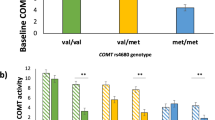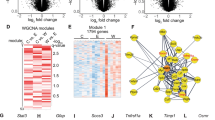Abstract
The central dopamine system seems to influence addictive disorders. Plasma homovanillic acid (HVA) is an indicator of central dopaminergic activity. In this study the hypothesis that plasma HVA is associated with alcoholism or with delirium tremens (DT) during alcohol withdrawal was tested. A functional genetic polymorphism of the enzyme catechol-O-methyltransferase (COMT) that participates in converting dopamine into its final metabolite HVA was investigated for an association with alcoholism or DT during alcohol withdrawal. In addition, a relation between the functional polymorphism of COMT and plasma HVA concentrations was studied. Plasma HVA concentrations and COMT genotypes were determined in 142 German alcoholics and 101 German healthy controls. Alcoholic patients were examined after a minimum of 3 weeks after cessation of drinking. Mean plasma HVA concentrations were significantly lower in alcoholic patients compared to healthy controls. A group of alcoholics with a history of DT during alcohol withdrawal (n=62) did not differ significantly in plasma HVA concentrations from alcoholics with a history of only mild withdrawal symptoms (n=67). The functional polymorphism of the human COMT gene was neither significantly associated with the diagnosis of alcoholism or DT during alcohol withdrawal nor with plasma HVA concentrations.
Similar content being viewed by others
Log in or create a free account to read this content
Gain free access to this article, as well as selected content from this journal and more on nature.com
or
References
Adamson MD, Kennedy J, Petronis A, Dean M, Virkkunen M, Linnoila M et al (1995). DRD4 dopamine receptor genotype and CSF monoamine metabolites in Finnish alcoholics and controls. Am J Med Genet 60: 199–205.
Aizenstein ML, Korf J (1978). Aspects of influx and efflux of homovanillic acid of rat cerebrospinal fluid. Brain Res 149: 129–140.
Amin F, Davidson M, Davis KL (1992). Homovanillic acid measurement in clinical research: a review of methodology. Schizophr Bull 18: 123–148.
Anggard E, Lewander T, Sjoquist B (1974). Determination of homovanillic acid turnover in man. Life Sci 15: 111–122.
Arango V, Underwood MD, Mann JJ (1994). Fewer pigmented neurons in the locus coeruleus of uncomplicated alcoholics. Brain Res 650: 1–8.
Boudikova B, Szumlanski C, Maidak B, Weinshilboum R (1990). Human liver catechol-O-methyltransferase pharmacogenetics. Clin Pharmacol Ther 48: 381–389.
Brannan T, Prikhojan A, Yahr MD (1997). Peripheral and central inhibitors of catechol-O-methyl transferase: effects on liver and brain COMT activity and L-DOPA metabolism. J Neural Transm 104: 77–87.
Cubells JF, Kobayashi K, Nagatsu T, Kidd KK, Kidd JR, Calafell F et al (1997). Population genetics of a functional variant of the dopamine beta-hydroxylase gene (DBH). Am J Med Genet 74: 374–379.
Daniels JK, Williams NM, Williams J, Jones LA, Cardno AG, Murphy KC et al (1996). No evidence for allelic association between schizophrenia and a polymorphism determining high or low catechol-O-methyltransferase activity. Am J Psychiatry 153: 268–270.
Davidson M, Giordani AB, Mohs RC, Mykytyn VV, Platt S, Aryan ZS et al (1987). Control of exogenous factors affecting plasma homovanillic acid concentration. Psychiatry Res 20: 307–312.
Elchisak MA, Polinsky RJ, Ebert MH, Kopin IJ (1982). Kinetics of homovanillic acid and determination of its production rate in humans. J Neurochem 38: 380–385.
Elchisak MA, Polinsky RJ, Ebert MH, Modlin LT, Kopin IJ (1979). Kinetics of homovanillic acid and determination of its production rate in the rhesus monkey. Life Sci 24: 1493–1502.
Elsworth JD, Leahy DJ, Roth RH, Redmond DE (1987). Homovanillic acid concentrations in brain, CSF and plasma as indicators of central dopamine function in primates. J Neural Transm 68: 51–62.
Fadda F, Colombo G Gessa GL (1991). Genetic sensitivity to effect of ethanol on dopaminergic system in alcohol preferring rats. Alcohol Alcohol 1 (Suppl.): 439–442.
Fujimoto A, Nagao T, Ebara T, Sato M, Otsuki S (1983). Cerebro-spinal fluid monoamine metabolites during alcohol withdrawal syndrome and recovered state. Biol Psychiatry 18: 1141–1152.
Fulton MK, Kramer G, Moeller FG, Chae Y, Isbell PG, Petty F (1995). Low plasma homovanillic acid levels in recently abstinent alcoholic men. Am J Psychiatry 152: 1819–1820.
Gabel S (1995). Homovanillic acid and dopamine-β-hydroxylase in male youth: relationships with paternal substance abuse and antisocial behavior. Am J Drug Alcohol Abuse 21: 363–378.
Geracioti TD, West SA, Baker DG, Hill KK, Ekhator NN, Wortman MD et al (1999). Low CSF concentration of a dopamine metabolite in tobacco smokers. Am J Psychiatry 156: 130–132.
Goldman D, Dean M, Brown GL, Bolos AM, Tokola R, Virkkunen M et al (1992). D2 dopamine receptor genotype and cerebrospinal fluid homovanillic acid, 5-hydroxyindoleacetic acid and 3-methoxy-4-hydroxyphenylglycol in alcoholics in Finland and the United States. Acta Psychiatr Scand 86: 351–357.
Grossman MH, Emanuel BS, Budarf ML (1992). Chromosomal mapping of the human catechol-O-methyltransferase gene to 22q11.1-q11.2. Genomics 12: 822–825.
Hallikainen T, Lachman H, Saito T, Volavka J, Kauhanen J, Salonen JT et al (2000). Lack of association between the functional variant of the catechol-O-methyltransferase (COMT) gene and early-onset alcoholism associated with severe antisocial behavior. Am J Med Genet 96: 348–352.
Harris GC, Aston-Jones G (1994). Involvement of D2 dopamine receptors in the nucleus accumbens in opiate withdrawal syndrome. Nature 371: 155–157.
Heinz A, Schmidt K, Baum SS, Kuhn S, Dufeu P, Schmidt LG et al (1996). Influence of dopaminergic transmission on severity of withdrawal syndrome in alcoholism. J Stud Alcohol 57: 471–474.
Heinz A, Weingartner H, George D, Hommer D, Wolkowitz OM, Linnoila M (1999). Severity of depression in abstinent alcoholics is associated with monoamine metabolites and dehydroepiandrosterone-sulfate concentrations. Psychiatry Res 89: 97–106.
Ishiguro H, Haruo-Shibuya T, Toru M, Saito T, Arinami T (1999). Association study between high and low activity polymorphism of catechol-O-methyltransferase gene and alcoholism. Psychiatr Genet 9: 135–138.
Jönsson EG, Goldman D, Spurlock G, Gustavsson JP, Nielsen DA, Linnoila M et al (1997). Tryptophan hydroxylase and catechol-O-methyltransferase gene polymorphisms: relationships to monoamine metabolite concentrations in CSF of healthy volunteers. Eur Arch Psychiatry Clin Neurosci 247: 297–302.
Katajamaki J, Honkanen A, Piepponen TP, Linden IB, Zharkovsky A, Ahtee L (1998). Conditioned place preference induced by a combination of L-dopa and a COMT inhibitor, entacapone, in rats. Pharmacol Biochem Behav 60: 23–26.
Kauhanen J, Hallikainen T, Tuomainen TP, Koulu M, Karvonen MK, Salonen JT et al (2000). Association between the functional polymorphism of catechol-O-methyltransferase gene and alcohol consumption among social drinkers. Alcohol Clin Exp Res 24: 135–139.
Keranen T, Gordin A, Harjola VP, Karlsson M, Korpela K, Pentikainen PJ et al (1993). The effect of catechol-O-methyl transferase inhibition by entacapone on the pharmacokinetics and metabolism of levodopa in healthy volunteers. Clin Neuropharmacol 16: 145–156.
Kiianmaa K, Tuomainen P, Makova N, Seppa T, Mikkola JA, Petteri-Pepponen T et al (2000). The effects of nicotine on locomotor activity and dopamine overflow in the alcohol-preferring AA and alcohol-avoiding ANA rats. Eur J Pharmacol 407: 293–302.
Klemetsdal B, Straume B, Giverhaug T, Aarbakke J (1994). Low catechol-O-methyltransferase activity in a Saami population. Eur J Clin Pharmacol 46: 231–235.
Lachman HM, Papolos DF, Saito T, Yu YM, Szumlanski CL, Weinshilboum RM (1996). Human catechol-O-methyltransferase pharmacogenetics: description of a functional polymorphism and its potential application to neuropsychiatric disorders. Pharmacogenetics 6: 243–250.
Lappalainen J, Long JC, Virkkunen M, Ozaki N, Goldman D, Linnoila M (1999). HTR2C Cys23Ser polymorphism in relation to CSF monoamine metabolite concentrations and DSM-III-R psychiatric diagnoses. Biol Psychiatry 46: 821–826.
McBride WJ, Bodart B, Lumeng L, Li TK (1995). Association between low contents of dopamine and serotonin in the nucleus accumbens and high alcohol preference. Alcohol Clin Exp Res 19: 1420–1422.
Meek JL, Neff NH (1973). Is cerebrospinal fluid the major avenue for the removal of 5-hydroxyindoleacetic acid from the brain? Neuropharmacology 12: 497–499.
Miller SA, Dykes DD, Polesky HF (1988). A simple salting out procedure for extracting DNA from human nucleated cells. Nucleic Acids Res 16: 1215.
Neff NH, Tozer TN, Brodie BB (1967). Application of steady state kinetics to studies of the transfer of 5-hydroxyindoleacetic acid from brain to plasma. J Pharmacol Exp Ther 158: 214–218.
Nestler EJ, Hope BT, Widnell KL (1993). Drug addiction: a model for the molecular basis of neural plasticity. Neuron 11: 995–1006.
Petrakis IL, Trevisan L, D’Souza C, Gil R, Krasnicki S, Webb E et al (1999). CSF monoamine metabolite and beta endorphin levels in recently detoxified alcoholics and healthy controls: prediction of alcohol cue-induced craving? Alcohol Clin Exp Res 23: 1336–1341.
Pietila K, Laakso I, Ahtee L (1995). Chronic oral nicotine administration affects the circadian rhythm of dopamine and 5-hydroxytryptamine metabolism in the striata of mice. Naunyn Schmiedeberg's Arch Pharmacol 353: 110–115.
Rivas E, de Ceballos ML, Nieto O, Fontenla JA (1999). In vivo effects of new inhibitors of catechol-O-methyl transferase. Br J Pharmacol 126: 1667–1673.
Salminen O, Ahtee L (2000). The effects of acute nicotine on the body temperature and striatal dopamine metabolism of mice during chronic nicotine infusion. Neurosci Lett 284: 37–40.
Sano H, Suzuki Y, Ohara K, Yazaki R, Ishigaki T, Yokoyama T et al (1992). Circadian variation in plasma homovanillic acid level during and after alcohol withdrawal in alcoholic patients. Alcohol Clin Exp Res 16: 1047–1051.
Sullivan JT, Sykora K, Schneiderman J, Naranjo CA, Sellers EM (1989). Assessment of alcohol withdrawal: the revised clinical institute withdrawal assessment for alcohol scale (CIWA-Ar). Br J Addict 84: 1353–1357.
Tiihonen J, Hallikainen T, Lachman H, Saito T, Volavka J, Kauhanen J et al (1999). Association between the functional variant of the catechol-O-methyltransferase (COMT) gene and type 1 alcoholism. Mol Psychiatry 4: 286–289.
Uzbay IT, Usanmaz SE, Tapanyigit EE, Aynacioglu S, Akarsu ES (1998). Dopaminergic and serotonergic alterations in the rat brain during ethanol withdrawal: association with behavioral signs. Drug Alcohol Depend 53: 39–47.
Virkkunen M, Eggert M, Rawlings R, Linnoila M (1996). A prospective follow-up study of alcoholic violent offenders and fire setters. Arch Gen Psychiatry 53: 523–529.
Wang T, Franke P, Neidt H, Cichon S, Knapp M, Lichtermann D et al (2001). Association study of the low-activity allele of catechol-O-methyltransferase and alcoholism using a family-based approach. Mol Psychiatry 6: 109–111.
Westerink BHC (1985). Sequence and significance of dopamine metabolism in rat brain. Neurochem Int 7: 221–227.
Wise RA (1988). The neurobiology of craving: implications for the understanding and treatment of addiction. J Abnorm Psychol 97: 118–132.
Wittchen HU, Zaudig M, Fydrich T (1997). SKID. Strukturiertes Klinisches Interview fuer DSM-IV (Users Guide for the Structured Clinical Interview for DSM-IV, modified version), (Original: First MB, Gibbon M, Spitzer, RL, Williams JBW (1996). SCID-I; SCID-II); Testzentrale, Robert-Bosch-Breite 25, D-37079 Goettingen.
Wood PL, Altar CA (1988). Dopamine release in vivo from nigrostriatal, mesolimbic, and mesocortical neurons: utility of 3-methoxytyramine measurements. Pharmacol Rev 40: 163–187.
Zhou FC, Zhang JK, Lumeng L, Li TK (1995). Mesolimbic dopamine system in alcohol-preferring rats. Alcohol 12: 403–412.
Acknowledgements
This study was financially supported by the ‘fortüne-fund’ (project 490) of Tübingen University, Germany. We thank Professor Dr Ursula Breyer-Pfaff of the Institute of Toxicology of Tübingen University for her advice in establishing the HPLC Method to detect plasma HVA.
Author information
Authors and Affiliations
Corresponding author
Rights and permissions
About this article
Cite this article
Köhnke, M., Wiatr, G., Kolb, W. et al. Plasma Homovanillic Acid: A Significant Association with Alcoholism is Independent of a Functional Polymorphism of the Human Catechol-O-Methyltransferase Gene. Neuropsychopharmacol 28, 1004–1010 (2003). https://doi.org/10.1038/sj.npp.1300107
Received:
Revised:
Accepted:
Published:
Issue date:
DOI: https://doi.org/10.1038/sj.npp.1300107
Keywords
This article is cited by
-
Catechol-O-methyltransferase (COMT) Val158Met Polymorphism and Susceptibility to Alcohol Dependence
Indian Journal of Clinical Biochemistry (2021)
-
Monoamine and genome-wide DNA methylation investigation in behavioral addiction
Scientific Reports (2020)
-
Self-perception and Experiential Schemata in the Addicted Brain
Applied Psychophysiology and Biofeedback (2008)
-
Homovanillic acid (HVA) plasma levels inversely correlate with attention deficit-hyperactivity and childhood neglect measures in addicted patients
Journal of Neural Transmission (2007)



